A strong sales strategy plan creates the foundation for a cohesive and successful sales organization. Sales strategies and initiatives also align salespeople on shared goals and empower them to do their best work — keeping them happy and successful, too.
In this guide, I’ll dig into some sales strategies and initiatives that I’ve found can help you generate more leads and close more deals. But first, let’s define what a sales strategy is.
Free Download: Sales Plan Template
Table of Contents
What is a sales strategy?
A sales strategy is a set of decisions, actions, and goals that inform how your sales team positions the organization and its products to close new customers. It acts as a guide for sales reps to follow, with clear goals for sales processes, product positioning, and competitive analysis.
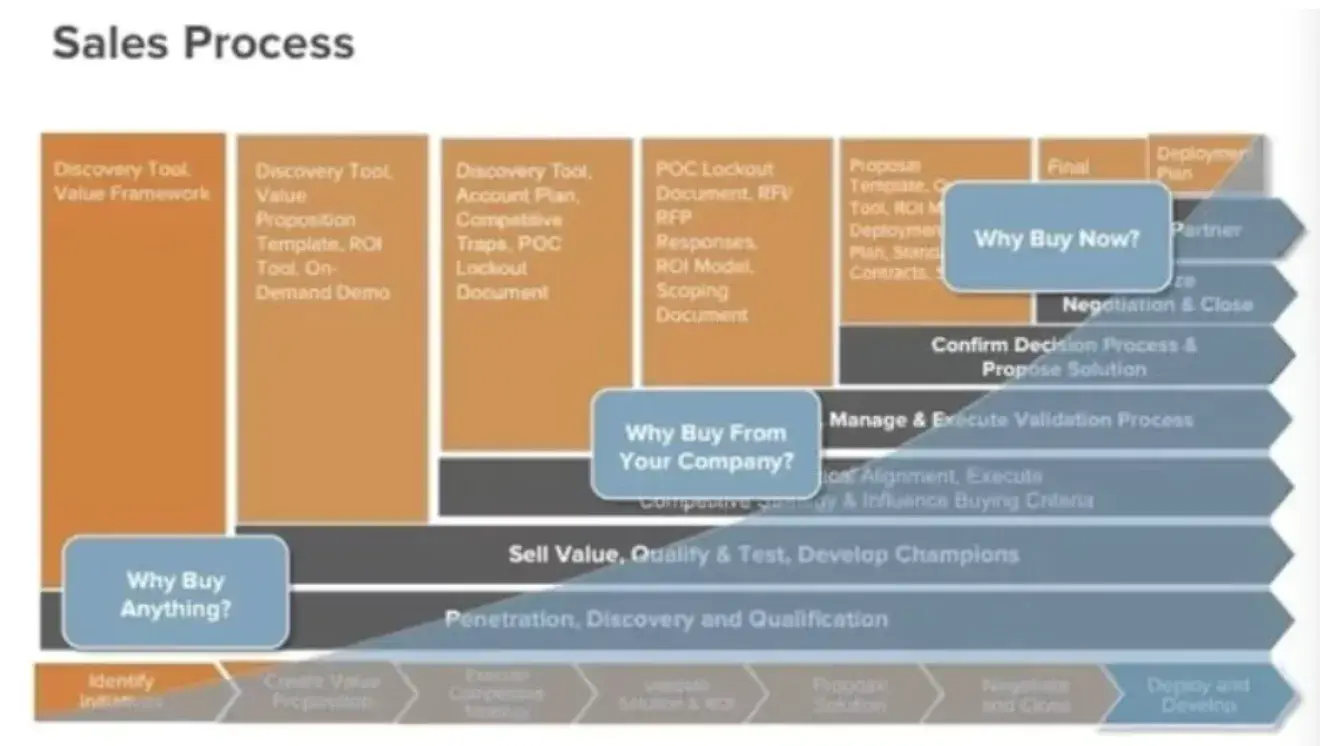
Most strategies involve a detailed plan of best practices and processes set by management.
https://www.youtube.com/watch?v=z25lC85v9Zw
Why is a sales strategy important?
A clear sales strategy serves as a map for the growth of your business. Your sales strategy is key to future planning, problem-solving, goal-setting, and management.
An effective sales strategy can help you:
- Give your team direction and focus. Strategic clarity can help your sales reps and managers understand which goals and activities to prioritize. This can lead to improved productivity and outcomes.
- Ensure consistent messaging. Your sales strategy can help your team deliver a consistent message to prospects, partners, and customers. This can increase both trust and effectiveness.
- Optimize opportunities. Strong sales strategies will help you target the right prospects and customize your approach. This can help your team make the most of every sales opportunity.
- Improve resource allocation. Your sales strategy outlines your priorities and resources. In turn, this can help your sales team use their time, effort, and other resources more efficiently, boosting your team’s ability to focus on high-potential deals.
Next, let’s cover some of the sales strategies that I’ve found can be most effective.

Free Sales Plan Template
Outline your company's sales strategy in one simple, coherent sales plan.
- Target Market
- Prospecting Strategy
- Budget
- Goals
Download Free
All fields are required.

Sales Strategy Types
The customer is the most important element to consider when choosing your business‘s sales strategy. Once you’ve addressed their needs, you can start thinking about your sales team. Your sales strategy should offer a framework that attracts and engages prospects — while simultaneously enabling your team to build relationships.
Prospects‘ and teams’ needs and interests vary, so your sales strategy shouldn’t be one-size-fits-all. Every sales org should draw up the type of sales strategy that works best for its priorities. Here are some frameworks you can reference when putting yours together.
Outbound Sales Strategy
Outbound sales strategies are the legacy approach of most sales teams. In these systems, companies base their sales strategy on the seller, not the customer.
Outbound sales processes often include cold calling, purchasing email lists, and engaging in other cold prospecting techniques. As a result, daily success metrics are often based on the quantity of connections, not the quality.
Outbound sales teams often rely on manually-entered data to monitor their sales pipelines and coach their salespeople. To enhance efficiency, outbound sales teams may utilize software to automate certain tasks, though the integration might not be seamless. They may also run sales and marketing independently, which can create a disjointed experience for buyers.
Inbound Sales Strategy
Inbound sales strategies are the modern methodology for sales teams. Companies following an inbound approach base their sales processes on buyer actions, capturing seller and buyer data to monitor their pipelines and coach their salespeople.
Inbound sales strategies connect reps’ activities to the three stages of the buyer journey — awareness, consideration, and decision — encouraging sales teams to map their tactics to each step.
The inbound methodology also aligns sales and marketing, creating a seamless experience for buyers. Check out this post to learn more about inbound sales and how to develop an inbound sales process.
Inbound vs. Outbound Sales Methodology
Nowadays, much of the information needed to evaluate a product is available online — empowering buyers and making them less reliant on sellers for product knowledge and insight. That means that if sales teams don’t align with the modern buyer’s process. If they fail to add value beyond the information already available online, then buyers will have no reason to engage with a sales team.
As mentioned above, inbound sales benefits buyers at each stage of the buyer process, including:
- Awareness.
- Consideration.
- Decision.
Inbound sales teams help buyers become aware of potential problems or opportunities and discover strategies to solve those problems.
Then, buyers evaluate whether the salesperson can help with their problem, and if the buyer thinks they can, they’ll purchase a solution to their problem. Inbound sales reps are helpful and trustworthy, creating partnerships rather than power struggles.
Consultative Selling
The modern sales professional should always act as a helpful, consultative resource for prospects. Consultative selling is a strategy that leans into that trend. It places emphasis on leading with relationship building and positioning the right product after that connection has been established.
This brand of sales involves certain key actions, including balancing questions with insights, developing trust with extensive product knowledge, active listening, and letting feedback guide conversations.
Obviously, this is an extremely high-level overview of the strategy — for a more granular picture of how it works, check out this article.
Account-Based Selling
Account-Based Selling (ABS) is a sales strategy that's rooted in locking in on key, higher-value accounts as opposed to casting a wide net for a broad range of prospects. With ABS, salespeople are expected to identify and pursue specific accounts that have high conversion potential.
That means salespeople are expected to conduct thorough, thoughtful research on prospects to more effectively meet them where they are. The strategy also places emphasis on collaboration with marketing — sales teams lean on their marketing departments to create personalized, targeted content for each account.
Ultimately, successfully executed Account-Based Selling rests on a sales team's ability to take a granular approach to really lock in on individual prospects' needs and interests. Salespeople leveraging the strategy also need to know how to prioritize the accounts they pursue.
ABS can be extremely effective if it's done right, but it does come with its share of risk — if your sales org elects to forego reaching out to a wide range of prospects in favor of connecting with key accounts, you generally have less room for error.
For a look at some other key methodologies that can inform your sales strategy, check out this article.
Below, I’ll walk through how to create a sales strategy plan for your team.
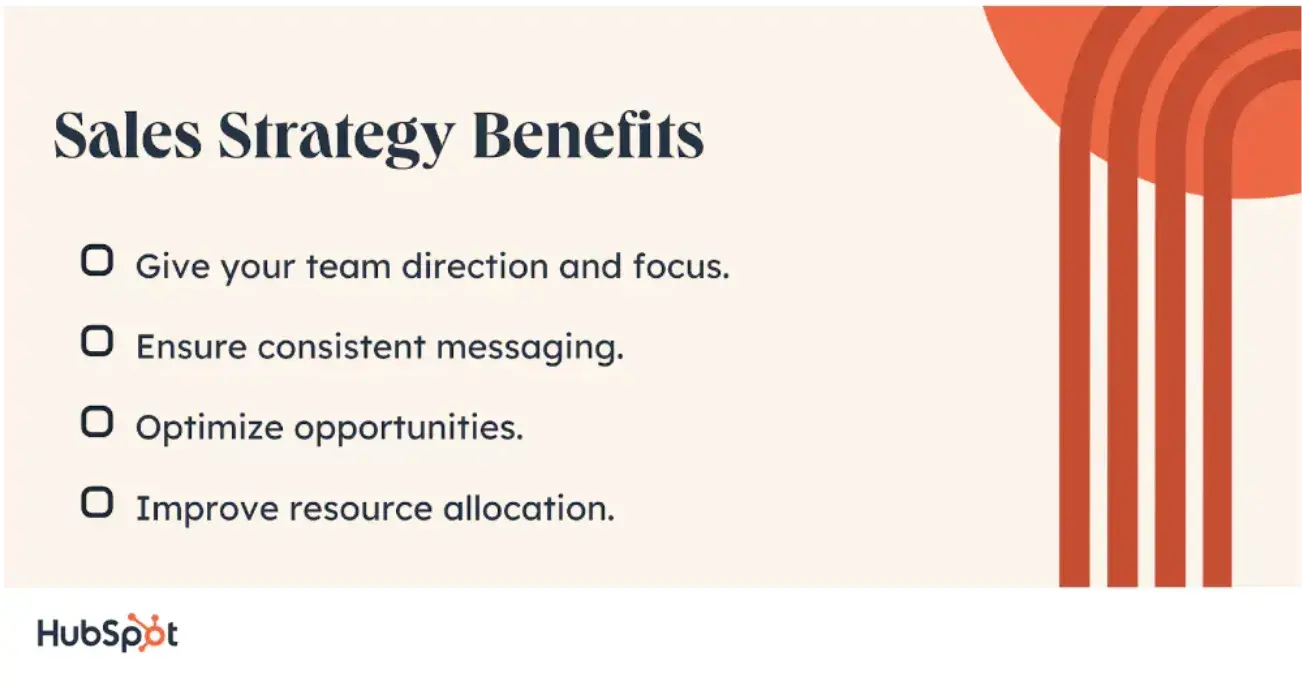
The Most Effective Sales Strategies
- Increase online sales through social media.
- Become a thought leader.
- Prioritize inbound sales calls as hot leads.
- Properly research and qualify prospects.
- Implement a free trial.
- Don't shy away from cold calling.
- Offer a demonstration of the product.
- Provide a personalized, clear end result.
- Be willing to adapt your offering.
- Close deals with confidence.
- Nurture existing accounts for future selling opportunities.
1. Increase online sales through social media.
More than 90% of retail businesses were active on at least two social platforms in 2022 — making social media one of the most effective avenues for increasing brand awareness and online sales.
While it may be tempting to jump on the hottest social media trend or just go wherever your competitors are, that probably won’t be your best choice. Instead, be diligent about figuring out where your target customers are spending their time and meet them where they’re most active.
It’s also important to keep in mind that to connect with your audience. You may need to adjust your tone and voice to match different platforms. You’ll want your content to blend in naturally with the platform and not seem out of place.

50+ for Social Selling on LinkedIn and Beyond
Use this guide to improve your social selling efforts and close more deals from platforms like...
- TikTok
- And more!
Download Free
All fields are required.

2. Become a thought leader.
Sharing your advice, tried-and-true best practices, and niche expertise are some of the most long-lasting ways to build your personal brand and lend more credibility to your organization.
That’s what thought leaders do. Indeed, a 2022 report found that “Thought leadership is one of the most effective tools an organization can use to demonstrate its value to customers during a tough economy — even more so than traditional advertising or product marketing, according to B2B buyers.”
According to the study, 61% of decision-makers believed that thought leadership could be moderately or very effective in demonstrating the value of a company’s products.So what’s the catch? Not all thought leadership content is created equal.
When done right, thought leadership can have a huge positive impact, but poor thought leadership can be devastating to a company’s sales goals. So, before you plan a spree of LinkedIn posts to drive leads, consider who your audience is, what they need to know, and how your organization can help
Also, it may not hurt to have a second set of eyes from your marketing, communication, and PR departments review your plan first to make sure everything is on-brand (and trackable!).
3. Prioritize inbound sales calls as hot leads.
You and your sales team know your process better than anyone. So take it from me — if you’ve seen success with pitching with pricing first, last, or somewhere in between, stick with what’s working for you.
Beyond that, your team should always prioritize the prospects who come to you. These hot leads are definitely interested in what you have to sell, and before they make a decision, they want to get the information they need about how it will benefit them.
By prioritizing talking to these prospects as soon as they call in or send an email, you’re putting your best foot forward and showing them that you’re helpful, solutions-oriented, and considerate of their time.
4. Properly research and qualify prospects.
I’ve personally discovered that even the strongest sales strategy can’t compensate for targeting the wrong customers. To ensure your team is selling to the right type of customer, encourage reps to research and qualify prospects before attempting to discuss your product. Indeed, throughout my career, I’ve found that more work on the front end can lead to smoother closing conversations later on.
Outline the criteria a prospect needs to meet to be qualified as a high-probability potential customer. These criteria will depend on your unique business and target audience, but they should generally be based on a prospect’s engagement history and demographics.
5. Implement a free trial.
HubSpot’s sales strategy report, free trials were the second most popular self-service tools among the survey's respondents for supporting sales strategies — with 41% citing it as one of the most effective of those kinds of resources.
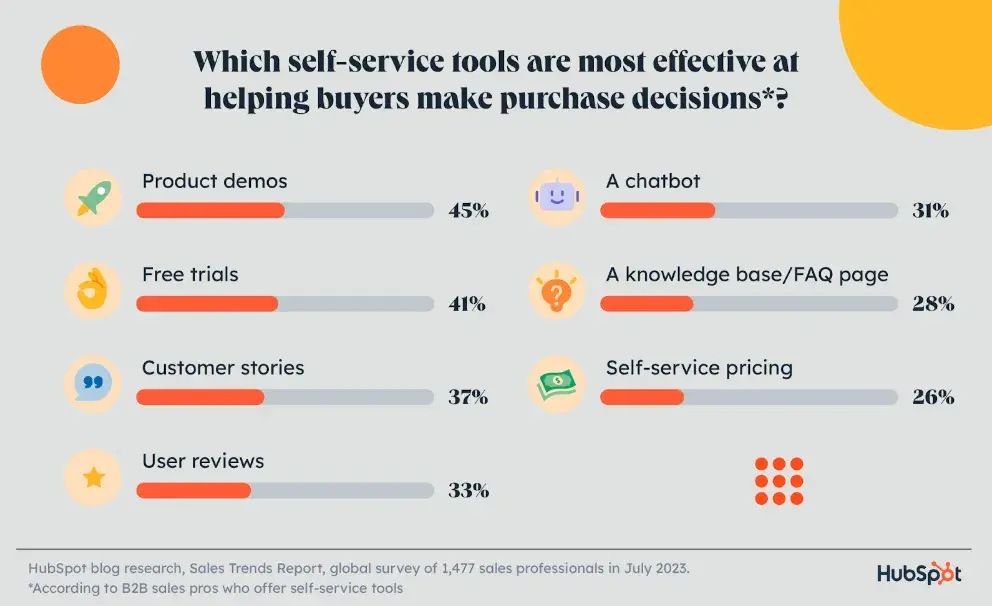
Free trials give potential customers the opportunity to test your product out before committing to it. To encourage users to switch to a paid version, you can place restrictions on your free version, such as limited features or usage caps — but it’s important to ensure that people still have a positive experience with the free trial.
6. Don’t shy away from cold calling.
In sales, cold calling is unavoidable. But it doesn’t have to be miserable. There are a number of cold-calling techniques that really work, including HubSpot’s bulletproof cold-calling template.
If your reps are feeling nervous, have them practice cold calls with one another before making actual calls. In my experience, that can be a great way to boost a sales team’s confidence and get everyone comfortable with the script.
I would also highly recommend using HubSpot Sales Hub's playbooks and conversation intelligence features here. Playbooks allow you to store call scripts for various scenarios along with other resources in a centralized database — it helps reps adjust their approach on the fly whenever needed.
Conversation intelligence records and stores calls directly within the platform. It then lets you examine each call and leave feedback on any given moment within a conversation.
7. Offer a demonstration of the product.
Pitching can be the make-or-break moment in a sales strategy. The sales pitch has to be a powerful, compelling presentation, but it also can’t come on too strong — otherwise, you risk scaring away the prospect.
To strike this balance, study the elements of a successful sales pitch and craft a narrative that illustrates to prospects how they’ll benefit from making the purchase. You can also test your presentations on a few loyal customers and gather their feedback, helping you optimize your pitch and ensure it clearly demonstrates your product’s value-add.
8. Provide a personalized, clear end result.
Prospects want to purchase a means to improve their own operations. So, after you walk through your offering, you have to personalize your explanation of its benefits — highlighting how your company can help each individual prospect in a way that’s valuable to them.
For example, if you’re selling customer service software to a small business that has no experience with similar tools, it’s your job to educate them on how your solution can add value in a small business setting. In this context, explaining how you’ve helped large customers manage hundreds of employees would be completely irrelevant and perhaps even confusing.
With this personalized approach, your prospects will have an easier time seeing how they can use your product or service, instead of getting stuck debating what they’ll even use it for.

Free Sales Plan Template
Outline your company's sales strategy in one simple, coherent sales plan.
- Target Market
- Prospecting Strategy
- Budget
- Goals
Download Free
All fields are required.

9. Be willing to adapt your offering.
In sales conversations, you should expect to come across clients with unique demands. Every company has its own structures and needs, so encountering some variability is only natural.
As Marco Sandrone, a sales leader for the global staffing company Gi Group, explains, “Sales is a dynamic and competitive field that requires constant learning and improvement…that’s why one of the key skills that salespeople need to succeed in today’s fast-changing business environment is adaptability.
“Adaptability is the ability to adjust to different situations and circumstances, and to respond effectively to new challenges and opportunities. It involves being flexible, creative, and resilient in the face of change.”
You can’t say yes to everything. But instead of immediately saying “we won’t” or “we can’t” to every customer requirement, make sure your sales strategy is adaptable and able to accommodate your customers’ requests.
10. Close deals with confidence.
How you close a sale is just as important as how you start the conversation. Encourage clear, concise, and firm closing techniques to make sure your sales team sets the right expectations and delivers on their promises.
https://www.youtube.com/watch?v=MciJog2y-3w
Keeping a list of proven, go-to closing techniques will help salespeople routinely win deals. Some of my favorite techniques include the ‘now or never close’ — i.e., “If you commit now, I can get you a 20% discount” — or the ‘question close,’ i.e., “In your opinion, does what I am offering solve your problem?”
To further improve your closing techniques and learn to close deals with confidence, check out this free, downloadable Sales Closing Guide.
11. Nurture existing accounts for future selling opportunities.
Account management is an incredibly important part of the sales process, as this is how you foster loyal, happy customers and identify cross-selling and upselling opportunities.
So, after your sales team sees success with its sales strategy, it’s vital to form a partnership between the sales team and customer service/success teams.
Remember: Ensuring customers’ continued satisfaction with your product or service will make them more likely to do business with your company again. You may even inspire them to advocate for it proactively.
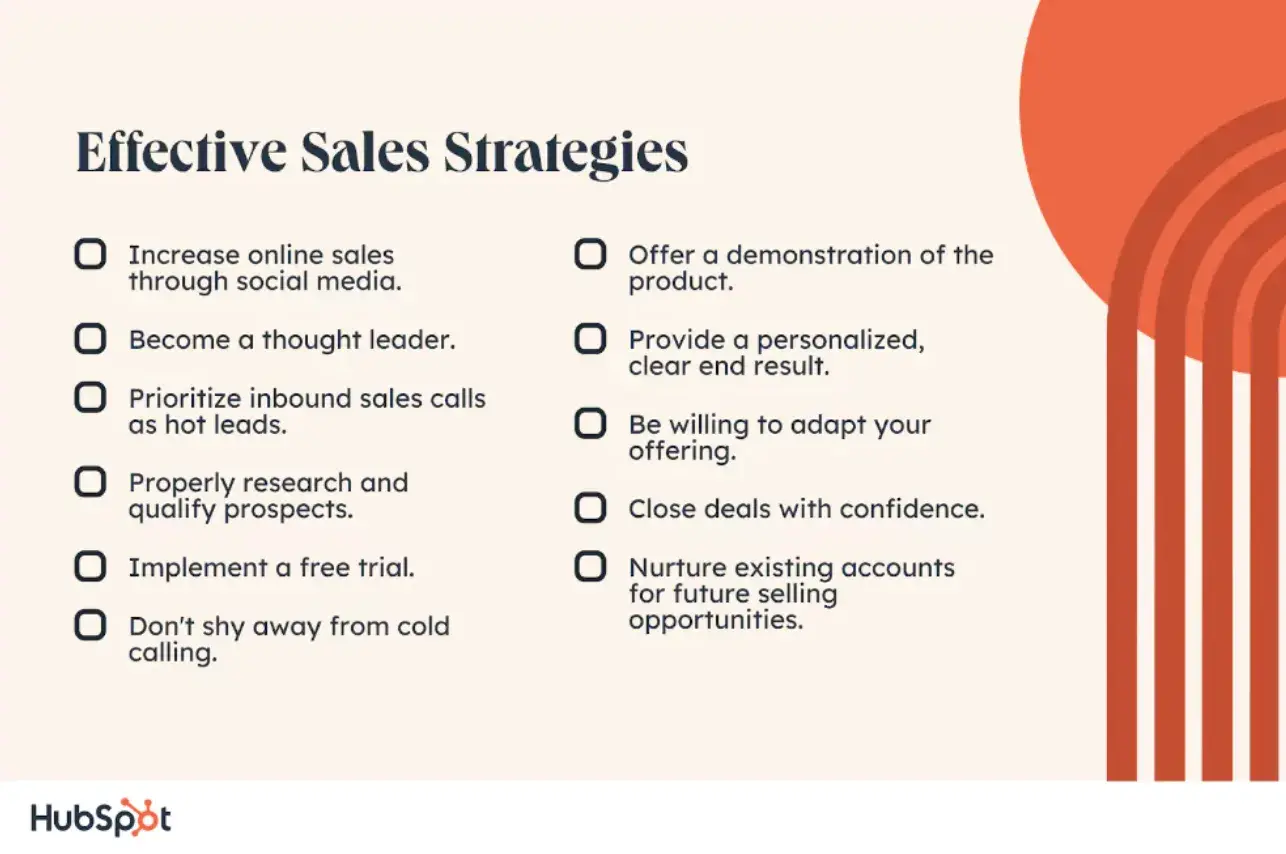
Now that you have the template you need, let’s go over how you can build a sales strategy.
How to Build a Sales Strategy
- Develop organizational goals.
- Create a customer profile that is tailored to a specific product offering.
- Hire, onboard, and compensate sales team members adequately.
- Create a plan to generate demand.
- Measure individual and team performance.
- Track sales activities.
To build a comprehensive sales plan, I’d recommend starting with the following activities:
1. Develop organizational goals.
Setting goals is a no-brainer for most sales teams. Otherwise, how will you know whether you’re executing the right activities or achieving the best results? There are three strategies that I’ve found can be particularly helpful in developing clear organizational goals for a sales strategy.
Involve cross-departmental stakeholders.
Avoid developing sales goals in a silo. Instead, be sure to get input from stakeholders across the organization, since every department is held accountable to the company’s bottom line.
Create SMART goals.
SMART stands for specific, measurable, attainable, relevant, and time-bound. Setting SMART goals can help your team simplify and track complex, long-term sales goals.
For example, a specific, measurable, and time-bound goal could be to sell 150% of the projected sales quota in Q2. Your internal team can propose this goal and then decide whether it is both relevant and attainable (attainability is particularly important because setting unrealistic goals can harm team motivation).
Connect individual goals to organizational goals.
If you’re creating a team-specific strategy, you may also want to set goals for individual team members. Building ownership and accountability into sales goals can help keep your team aligned, and it also makes your sales strategy more cohesive.
2. Create a customer profile that is tailored to a specific product offering.
A detailed profile of your target customer — a buyer persona — is an essential component of an effective sales strategy. Below, I’ve outlined the key steps to take when creating a buyer persona to ensure you come up with a useful profile:
Find target markets and segments.
First, look at your industry as a whole. Get a sense of your ideal customer’s company size, psychographics, and buying process. You may want to look at industry trends, too.
Conduct market research to understand customer needs and preferences.
Next, do some market research. This template can help you streamline the process and understand which types of research will be best for your business.
You may also want to do some competitor analysis at this stage. Once you know the strengths and weaknesses of competing brands, you can more easily find gaps that you can fill for specific customers.
Create a clear value proposition to attract your ideal customer to your product or service.
Finally, make sure your product offering outlines the benefits of your product for your target customer. It’s important to use insights from your customer profile to emphasize features that solve your target customer’s pain points.
Your business may already have a clear value proposition — but if not, you can use these free value proposition templates to draft one.
Quick tip: Be sure to schedule time to update and refine your buyer persona to make sure it stays aligned with current customer trends and expectations.
3. Hire, onboard, and compensate sales team members adequately.
To develop an effective sales strategy, you need to have a powerful sales team in place. That means investing in hiring, onboarding, and retaining top talent. Specifically, I have learned that there are three key components of building (and keeping) a supportive, successful sales team:
.png)
Free Sales Training Template
Use this template to set up a 30/60/90 day sales training and onboarding plan.
- 30/60/90 Day Goals
- People to Meet
- Feedback/Review Process
- And More!
Download Free
All fields are required.
.png)
Create great processes for hiring new members of your sales team.
First and foremost, create a list of criteria for sales managers to screen for when interviewing candidates. A well-defined job description and competency framework are also useful. These tools can help your team recruit and retain top talent.
Develop sales onboarding, training, and development programs.
Your training and onboarding program should prepare your sales team to sell effectively and efficiently. It should also help sales reps build advanced skills and industry knowledge.
But what if you don’t have the resources to develop comprehensive training in-house? In these situations, it may be worth considering combining organization-specific training with online sales training programs.
Create a motivational compensation and rewards plan.
Finally, once you’ve built a strong team, it’s vital to ensure your compensation plan is set up to motivate and retain them.
Many organizations connect sales compensation to organizational sales goals, but regardless of the specific compensation plan you choose, make sure that it meets or exceeds industry expectations. It should also inspire your team to celebrate individual and team achievements.
4. Create a plan to generate demand.
Now, it’s time to put together a detailed plan for how to target potential customers and increase their awareness of your offering. This may include using paid social acquisition channels, creating e-books, hosting webinars, and the many other strategies laid out in this article.
Featured Resource: Sales Plan Template
Download the Template for Free
As you create your sales plan, here are some of my top tips to remember:
Create targeted messaging and positioning for your target audience.
Targeted positioning will help your team create a foundation for reaching your top-priority audiences. It will also help you choose the best channels and tactics for each campaign, boosting your chances of increasing demand and identifying qualified leads with your sales strategy.
Add clear goals and KPIs to your sales plan.
In my experience, clear goals are critical both to help you stay motivated and to make sure you’re able to track the effectiveness of your sales strategies. Tracking these metrics can also help you change or update your strategies to increase their effectiveness over time.
Create processes for lead nurturing and follow up.
Once you’ve generated some demand, it’s time to start converting. Of course, not every lead generation opportunity translates into a qualified lead or sales opportunity.
As you track your newly generated demand, find ways to align your processes with your buyers’ journeys. Then, use sales automation tools to manage your leads and create personalized follow-ups. This can help every rep on your team send the right message at the right time.
Optimize your sales plan and process.
It’s also essential to build in time to review your metrics. Then, you can use A/B testing, customer feedback, and sales team insights to refine your sales strategy plan further.
5. Measure individual and team performance.
Once you’ve set up your infrastructure, you’ll want to start creating procedures for tracking performance on the individual, team, and company levels. Tracking your efforts is imperative to optimize your processes and practices for future growth. Even if you’re just getting started with setting benchmarks for the team, write those goals down and track your progress toward them.
Build useful metrics to track sales performance.
This can take the form of quarterly KPIs, weekly dashboards, monthly reviews, or some combination of all three. Whatever cadence you choose, your process should also highlight the specific metrics that the team should focus on.
If you’re not sure where to start, these commonly-used KPIs can help you align performance expectations with sales goals:
- Revenue targets.
- Sales quotas.
- Conversion rates.
- Lead-to-opportunity ratios.
- Average deal size.
- Pipeline velocity.
Think about real-time performance tracking.
While business KPIs are useful for the long-term, fast-moving industries may need real-time tracking as well. To get an at-a-glance look at sales team performance, I’d suggest looking into tools that can give you instant visibility, such as HubSpot’s Sales Hub.Real-time insights can help you quickly find and address issues, creating opportunities for proactive sales performance management.
Create a process for sharing performance data.
Ultimately, tracking performance metrics gives you the data you need to offer constructive feedback and coaching to each member of your team. Whether you communicate via one-on-one meetings, performance reviews, or team huddles, it’s important to make space for these conversations. Regularly sharing and discussing performance data is a great way to understand performance gaps, offer guidance, and share best practices.
.png)
Free Sales Metrics Calculator
A free, interactive template to calculate your sales KPIs.
- Average Deal Size
- Customer Acquisition Cost (CAC)
- Customer Lifetime Value (CLV)
- And more!
Download Free
All fields are required.
.png)
6. Track sales activities.
Data is key to an effective sales strategy plan. With sales activity metrics, you can go beyond individual team performance to understand your entire sales operation.
Collect a range of sales activity data.
Sales activity metrics can help you understand how the team approaches day-to-day sales as a whole. I’ve found that it can be helpful to track everything from the sales presentation to closing techniques.
Specifically, collect data to see how your sales team performs beyond call or deal numbers in activities, such as:
- Meetings scheduled.
- Presentations delivered.
- Proposals submitted.
- Sales presentation success rates.
- Closing techniques.
Then, comparing this data to other goal metrics can show you patterns, best practices, and areas for improvement.
Track, lead, and prospect sources.
It’s also vital to make sure you’re tracking where your prospects are coming from. For example, if you’ll be publishing thought leadership content or sourcing leads from social media, make sure that any link you share is trackable with a UTM parameter.
Trackable links aren’t just valuable for learning which channels are generating the most leads. They can also help you focus your resources on the channels that generate the most relevant, qualified leads for driving sales.
Focus on continuous improvement.
Once you have a complete set of analytics to track your strategy, use that data to refine your sales strategies, team knowledge, and plans. A clear, data-driven process will make it easier to use customer feedback to grow your sales. It will also give your sales team the agility to adapt to industry and market changes that may impact your business down the road.
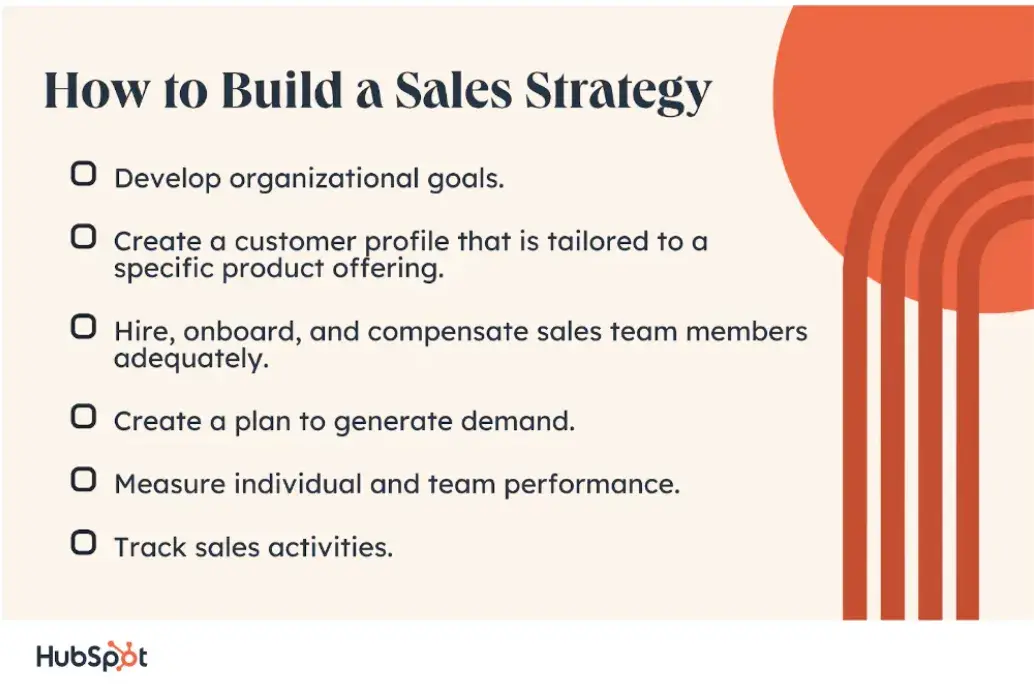
Sales Initiatives
- Refresh your buyer personas regularly.
- Actively align sales and marketing.
- Use a CRM.
- Listen to your prospects.
- Invest in sales development and team-building.
Businesses should always be looking for ways to innovate their approach to sales. Of course, it can be hard to know where to start — so here are some creative initiatives that can help sales reps and teams jumpstart their performance, stand out from the competition, and boost team productivity.
1. Refresh your buyer personas regularly.
Buyer personas inform all kinds of activity at your business, including (and most importantly) who your marketing and sales teams pursue as customers.
As your market and company shift, your buyer personas can become out-of-date, causing your sales team's work to become stagnant and ineffective. As such, it’s critical to work with your marketing team to refresh your buyer personas regularly to best equip your sales team for prospecting and outreach.
2. Actively align sales and marketing.
To align your sales team with your company’s marketing efforts, create and honor a service-level agreement (SLA) between your sales and marketing teams. This agreement will detail how each team can support each other, contribute to each other’s goals, and honor boundaries in a way that still moves prospects toward conversion.
Download our free SLA Template for Sales & Marketing to align sales and marketing goals and activities.
3. Use a CRM.
Successful sales teams and strategies require the right tools.
HubSpot’s all-in-one CRM eliminates manual work and streamlines your sales activity and data. It also keeps your sales team up-to-date about all relevant activity with your prospects, enabling new levels of transparency to motivate and align your team.
You can also use it alongside HubSpot’s marketing analytics software to get a complete overview of how prospects move throughout your sales funnels and streamline operations on both sales and marketing fronts.
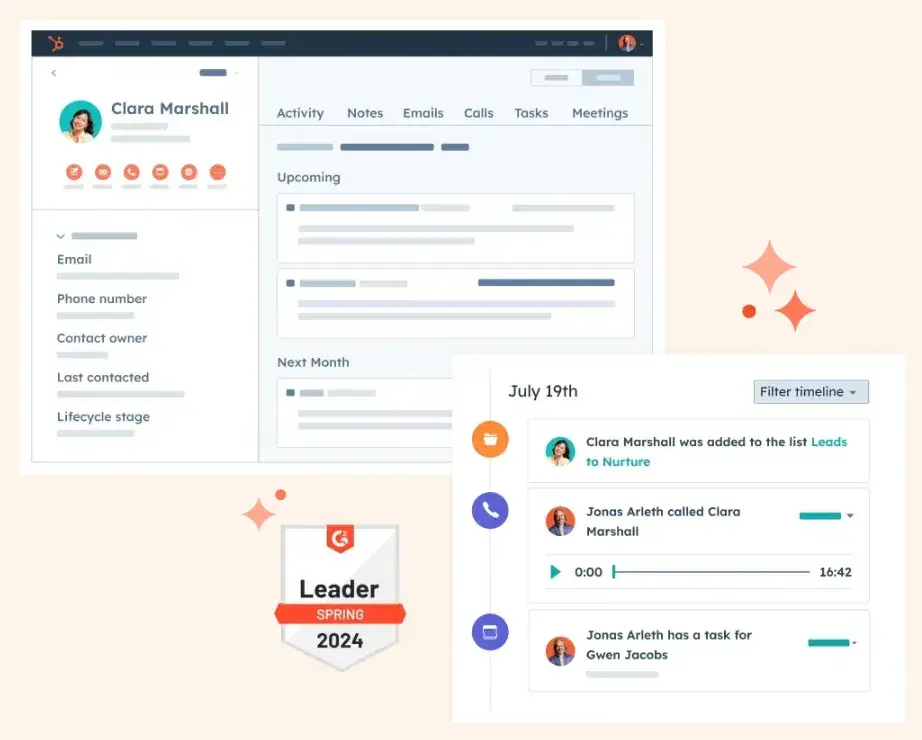
4. Listen to your prospects.
Just because prospects aren’t customers yet doesn’t mean they don’t have valuable feedback to offer.
As you move prospects through the sales funnel (and especially when they drop off), ask for candid feedback about their experience with your team and products. Even if they’ve lost interest, you may learn something that can help you convert your next prospect.
5. Invest in sales development and team-building.
The best sales teams align not only with their customers but also with their coworkers.
Sales is a difficult career, and without proper encouragement and camaraderie, people can easily become burned out. So, to keep your sales team feeling satisfied and supported, don’t forget to invest in sales development and team-building activities.
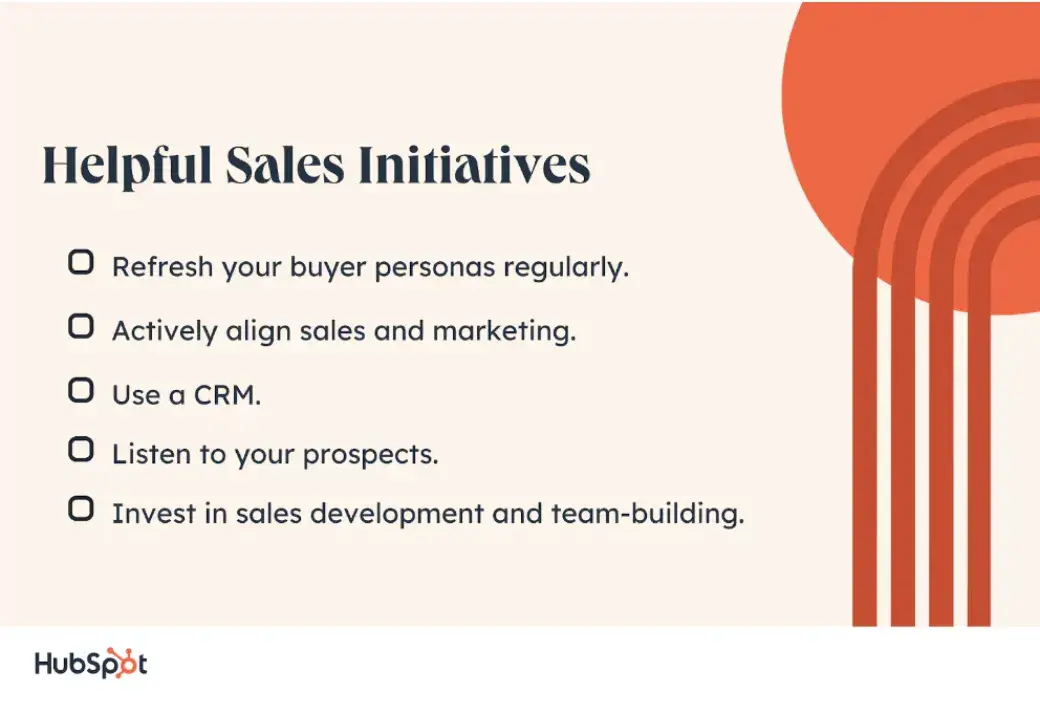
Sales Strategy Examples from Successful Sales Teams
Below, I’ve analyzed two incredibly high-performing sales teams to help shed light on how their unique sales strategies helped them achieve success.
1.HubSpot
Founded in 2006, HubSpot has grown to serve more than 184,000 customers in over 120 countries, bringing in more than $1.7 billion in annual revenue. HubSpot IPO'd in 2014, and the company is now valued at over $24.63 billion.
Here are a few pages from the HubSpot sales strategy playbook.
Hire the right people according to repeatable evaluation criteria.
HubSpot started by defining a list of attributes that made a successful sales rep: Strong work ethic, coachability, intelligence, passion, preparation and knowledge of HubSpot, adaptability to change, prior success, organizational skills, competitiveness, and brevity.
From there, the team established a repeatable process to evaluate candidates during interviews based on these weighted criteria.
Train the sales team by making them wear customers’ shoes.
Next, the team outlined its unique value proposition, target customer, competition, most common objections, product features and benefits, and so forth. Hubspot then created a hands-on training program that would not only imitate the sales process for reps before they actually began selling, but also allowed them to experience their target customers’ pain points for themselves.
Today, a large part of HubSpot’s training program involves having reps create their own website and blog and then drive traffic to it. This exercise allows reps to better understand and support potential customers in the future. The organization also uses exams, certification programs, and presentations to measure each rep’s performance.
After employees are onboarded, HubSpot continues tracking their progress throughout the various stages of its sales process. The primary criteria the team looks at include leads created, leads worked, demos delivered, and leads won. Then, these criteria are measured against each other to create ratios such as leads created versus leads won.
Finally, HubSpot’s sales leaders track each stage in the process, so that if a rep is struggling with any particular metric, they can dig deeper to understand why that’s the case and what they can do to help.
Align sales and marketing.
In addition, HubSpot’s sales and marketing teams work closely together in a process affectionately known as “Smarketing.” This helps both organizations collaboratively generate consistent leads each month.
Thanks to this process, marketing teams understand which qualities a lead needs to meet before it’s handed over to sales, as well as how many of those qualified leads it must create each month to meet sales projections.
At the same time, the sales team understands how long they should wait before contacting a lead and how many attempts they should make to contact that lead. All of these decisions are led by data and science, rather than guesswork or gut feelings.
.png)
Free Marketing & Sales SLA Template
Align Sales & Marketing goals with this free template.
- Goals
- Initiatives
- Accountability
- Communication
Download Free
All fields are required.
.png)
2. Shopify
Known for its consistent sales momentum and customer satisfaction, Shopify offers another great example of a highly successful sales organization. In a recent press release, Loren Padelford, shopify VP and general manager of Shopify Plus, shared his secret sauce for boosting sales.
Hire great people, not necessarily great salespeople.
Hiring is arguably one of the most essential components of a great sales strategy. Many sales managers, though, are misled into believing that they must hire sales superstars.
Instead, Padelford looks for six key traits when hiring salespeople: intelligence, work ethic, a history of success, creativity, entrepreneurship, and competitiveness.
The truth is that sales teams must first look for great people. Then, you can train them to help them become great salespeople.
Treat sales as a science, not an art.
Padelford describes how, thanks to modern digital tools, we can now measure sales down to the second. We can explain success with cold, hard data points, rather than turning to vague, qualitative assessments.
As such, every sales team today should be tracking their average deal size, average sales cycle length, lead-to-deal conversion rate, calls per day per rep, and the number of deals in the pipeline.
When tracked over time, each of these metrics can inform companies about the health of their sales process and help them pinpoint areas where they need to improve.
Build a smart, technological foundation.
Before Padelford took over the sales process at Shopify, sales reps would manually log phone calls and emails into a CRM, consuming five precious hours each week. With a sales force of 26 reps, that added up to 130 wasted hours per week.
Realizing this misuse of time and capital, Padelford led Shopify to adopt the HubSpot CRM. With this modern CRM, Shopify’s sales reps were able to receive notifications when prospects opened their emails, clicked links, and viewed document attachments.
In addition, its prospecting tool gave reps access to more than 19 million prospects, as well as detailed information about these prospects, such as estimated revenue, number of employees, suggested email addresses, and so on.
Maintain a high-quality pipeline by eliminating unqualified leads.
Shopify uses a 4/5 Threshold to filter out unqualified leads, thereby allowing its sales reps to focus on selling to leads who have a higher probability of becoming customers.
To evaluate whether a lead is qualified, a rep must have a concrete answer to four of the following five variables:
- Pain. Is the prospective customer experiencing a prominent business issue or challenge that requires them to make a change?
- Power. Is the prospective customer directly involved with the decision-making process? If not, who is?
- Money. Does our offering fall within their budget constraints?
- Process. What’s their buying process?
- Timeline. What stage are they at in the buyer’s journey? Will they purchase within a reasonable time frame?
Grow Better with Sales Strategies, Initiatives, and Templates
Every company can benefit from crafting a sales strategy plan. The free template below includes everything you’ll need to customize your strategy for your business and sales team.
Most importantly, regardless of what strategy you choose, always implement a buyer-first approach. With the strategies, initiatives, and examples described above, you’ll be on your way to leading a successful, high-performance sales team.
Editor's note: This post was originally written in April 2020 and has been updated for comprehensiveness.

Free Sales Plan Template
Outline your company's sales strategy in one simple, coherent sales plan.
- Target Market
- Prospecting Strategy
- Budget
- Goals
Download Free
All fields are required.



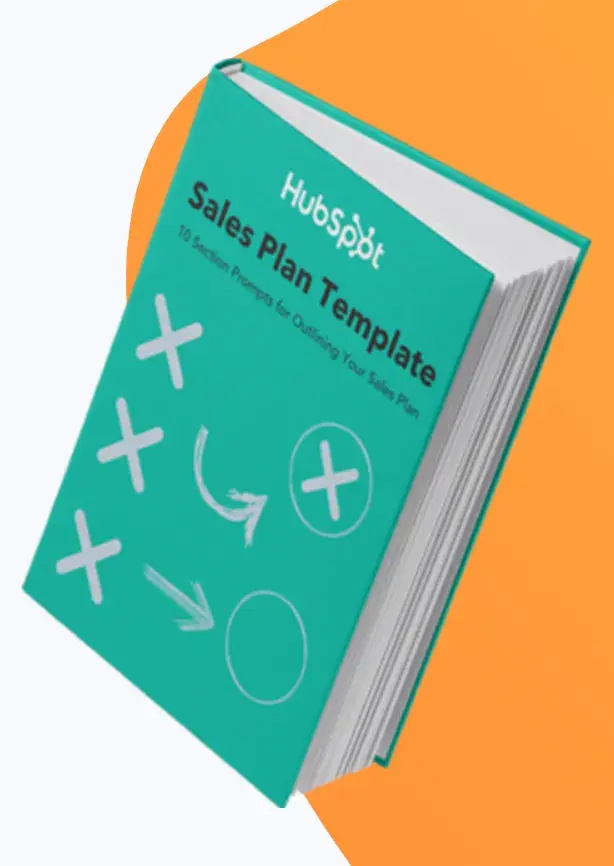
![What Is Cross-Selling? Intro, Steps, and Pro Tips [+Data]](https://knowledge.hubspot.com/hubfs/ft-cross-selling.webp)

![Want to Create a Sales Plan? Let Me Show You How [+ 10 Sales Plan Examples]](https://www.hubspot.com/hubfs/how-to-create-a-sales-plan-1.jpg)






![How to Reply to a Sales Rejection Email From a Client [+ Templates]](https://www.hubspot.com/hubfs/timing-objection-responses-1.jpg)